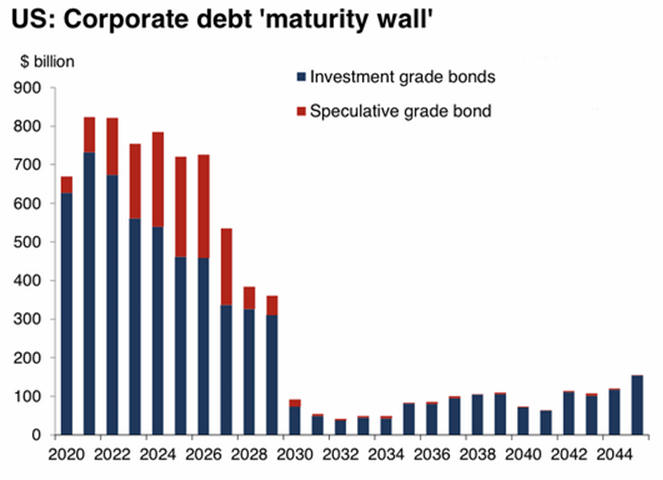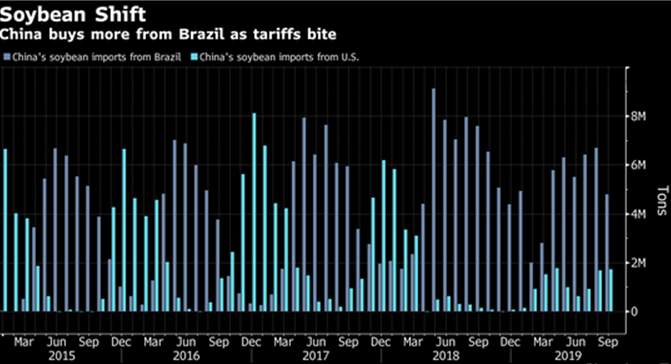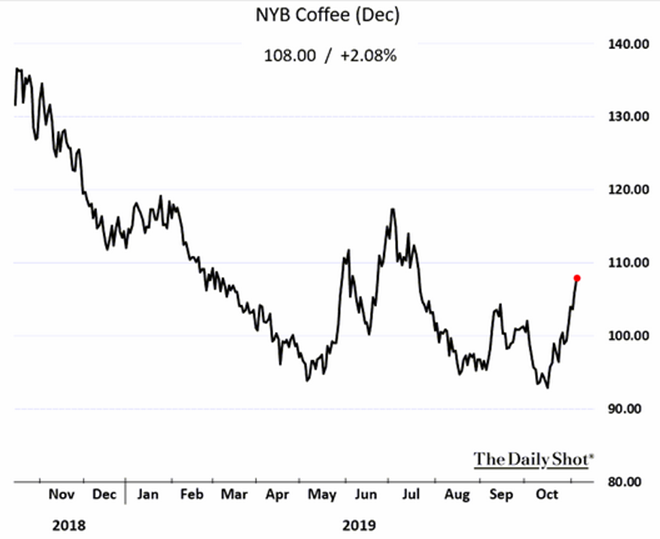News on earnings has been largely popular thus far as many companies continue to outperform expectations, but it isn't all good news for corporate America; $4 trillion of maturing debt is coming due over the next five years, and the historically low interest rate environment only complicates the picture. If economic growth slows further, as it is projected to do, and rates rise, both the companies themselves and fixed-income investors may be in for a bumpy ride. And though optimism around reaching a phase one trade deal—particularly following China's announcement yesterday that an agreement had been reached to begin rolling back tariffs—drove stocks to close at record highs, President Trump confirmed this morning that he "[hasn't] agreed to anything" While investors felt some impact of dashed hopes as markets fell this morning, it's the American farmer who continues to take the brunt of the ongoing conflict: the U.S. has now lagged behind Brazil in soybean exports to China for nearly double the period typical of previous cycles. Finally, while there's been some debate around valuation ahead of the "world's biggest IPO," there's no doubt the number will be staggering. Should Saudi Aramco float even just 2%, it's projected to raise $30 billion and outpace Alibaba (the current title holder) by over $8 billion. But is the timing right?
1. The surge in newly issued, low interest rate U.S. corporate debt may have an ugly future. If rates rise, the reinvestment risks could loom large...

Source: Oxford Economics, as of 11/7/19
2. Capitalism is stronger than an imperfect tariff. Here, as the tariffs kicked on soybeans, the Chinese just bought from a different supplier. Who got hurt? The U.S. farmer...

Source: Bloomberg, from 11/5/19
3. A look back at the mega-caps relative to the market...

Source: WSJ Daily Shot, as of 11/8/19
4. After a lengthy process of nationalizing their oil field in the second half of last century, why are they selling now?

Source: Statista, as of 11/4/19
5. Coffee prices have fallen over 40% in the last 18 months. Did your favorite coffee shop pass this through? I bet they pass any price rebound through!!!

Source: WSJ Daily Shot, as of 11/7/19
6. Maybe they passed it through in Turkey, but it looks like not in Denmark!

Source: Finder, as of 9/30/19
7. When the top schools cost over $100,000/year, a rational business student starts doing a cost-benefit analysis...

Source: WSJ Daily Shot, as of 11/8/19
Here's the truth: market volatility is unnerving, and many investors can find themselves either panic-selling or white-knuckling their way through rocky periods in the market. We believe there is a better, more methodical way to manage volatility in pursuit of successful long-term investing. Read “Our Take on Volatility” by Assistant Portfolio Manager Denis Rezendes, CFA to learn more.
Disclosure: The charts and info-graphics contained in this blog are typically based on data obtained from 3rd parties and are believed to be accurate. The commentary included is the opinion of the author and subject to change at any time. Any reference to specific securities or investments are for illustrative purposes only and are not intended as investment advice nor are a recommendation to take any action. Individual securities mentioned may be held in client accounts.


